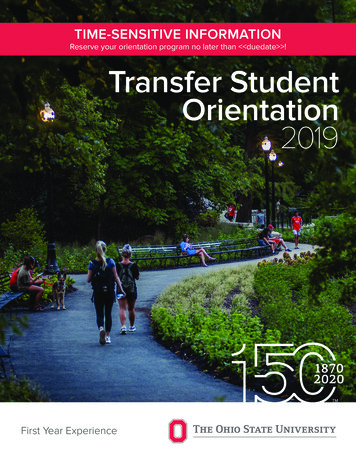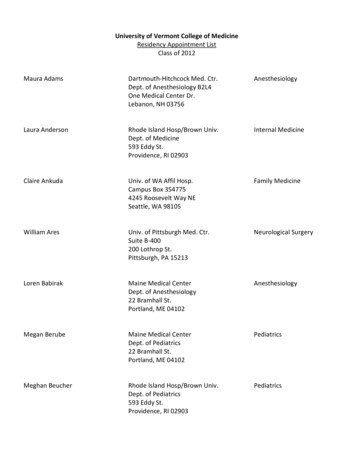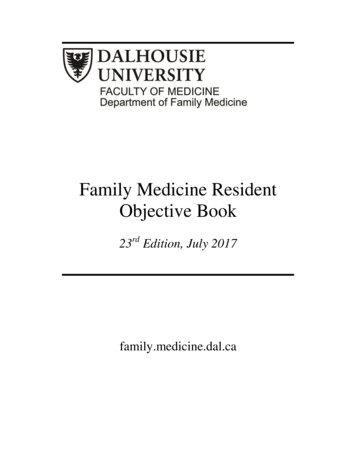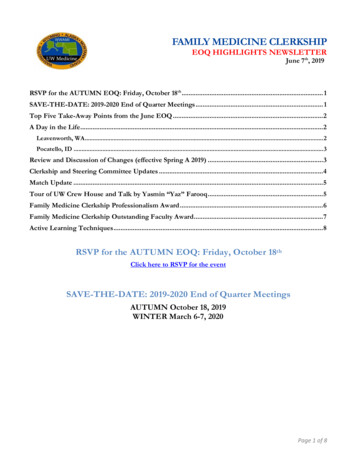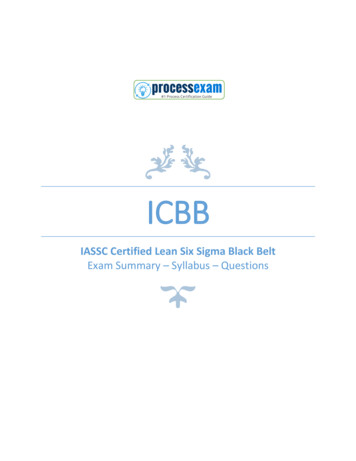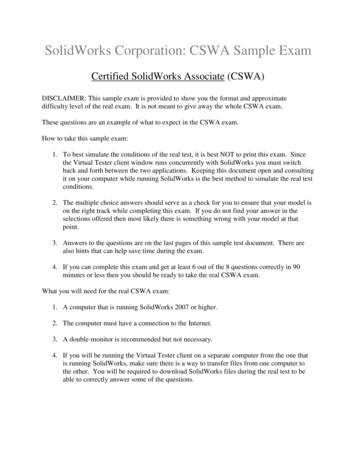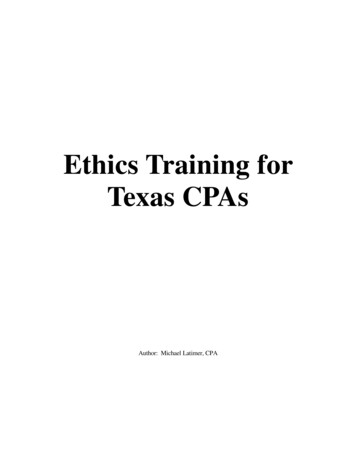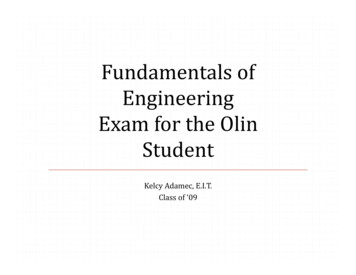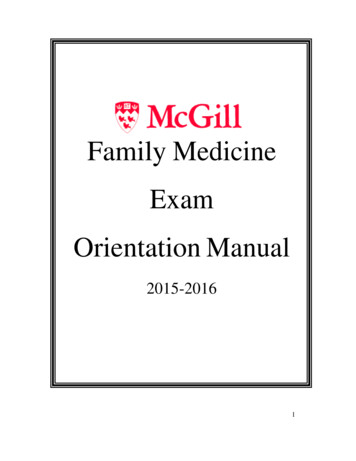
Transcription
Family MedicineExamOrientation Manual2015-20161
ANNOUNCEMENT*** Effective January 1, 2016, the College of Family Physicians of Canada(CFPC) and the Medical Council of Canada (MCC) will modify the examinationprocess for family medicine candidates. Upon review, the CFPC has determinedthat the Certification Examination in Family Medicine, featuring content fromboth organizations, has not resulted in the anticipated benefits for theCertification decision. For this reason, starting in 2016, the exams will be run astwo separate examinations, as they were before 2013. The MCC respects thisdecision and will work with CFPC to create a transition that is as seamless aspossible for candidates.2
McGill Family Medicine Exam Orientation Manual 2015-2016Table of ContentsIntroductory Letter to Residents.4Reminder of Important Exam Preparation Dates.6Short Answer Management Problems (SAMPs) .7SAMPs INSTRUCTIONS for the on line demonstration as per the CFPC website .8Introduction to the SOOs .19Preparation for the Simulated Office Orals (SOOs).21Anatomy of a SOO .25Sample SOO (Case 33 & Marking Scheme) .29Objective Structured Clinical Examination (OSCE)/ Medical Council of Canada .49Reference List for Home Study .57ALDO – General Information .60Working Knowledge of French Language .623
Introductory Letter to ResidentsDear Residents,This orientation manual has been prepared by the members of the McGill UniversityFamily Medicine Exam Committee to help you understand the Family MedicineExams.The Harmonized Certification Examination in Family Medicine was launched in thespring 2013. However, effective January 1, 2016, the College of Family Physiciansand the Medical Council of Canada will modify the examination process for familymedicine candidates. The exam will run as two separate examinations as they werebefore 2013.Until the end of 2015 the harmonized format of the exam will continue to beadministered. For those residents who may be taking this exam in October 2015 itincludes the following components:1. A full day of computer-based short answer management problems (SAMPs),based on the College of Family Physicians of Canada’s (CFPC’s) EvaluationObjectives.2. A clinical skills assessment consisting of:a.) 4 simulated office orals (SOOs), based on the CFPC’s EvaluationObjectives.b.) 8 objective structured clinical examination (OSCE) stations, based on theMedical Council of Canada’s Evaluation Objectives for the QualifyingExamination.In 2016 the Family Medicine exams will have the following two components:1. The College of Family Physicians of Canada (CFPC) examination whichincludes the written component, consisting of computer-based short answermanagement problems (SAMPS) and the clinical skills component, consistingof five simulated office orals (SOOs).2. The Medical Council of Canada qualifying examination part II (MCCQE-II)which consists of a series of clinical (OSCE) stations (10 minute stations, and6 minute couplet stations).Candidates taking the Certification examination in 2016 or later will need to registerseparately for the MCCQE Part II in order to obtain their LMCC.It should be noted that some residents in the Spring 2016 cohort have beenaccepted to do the MCCQE-II exam in October 2015.Please refer to the CFPC and MCC websites for in- depth information on the CFPCand MCC exams: www.cfpc.ca and www.mcc.ca.4
Residents who intend to practice in Quebec must have a working knowledge of theFrench language and must also fulfill requirements for the ALDO-Quebeceducational activity. The ALDO is about the legal, ethical and organizational aspectsof medical practice in Quebec. For further information about these requirementsplease log on to the CMQ website: www.cmq.org.In this manual you will find:1. The dates of practice exams and scheduled exams for 2015-2016.2. Descriptions of the different examination instruments that you will encounter,in order to help you to understand and to prepare for the certification andlicensing exams.3. Sample questions and cases of the CFPC exams.4. References and web sites for your home study.Please note that on the CFPC website (www.cfpc.ca) under Exam Information andunder Certification Examination in Family Medicine there is valuable informationabout the CFPC examinations including an online demonstration version of theSAMPs, sample SAMPs, video demonstrations of 2 SOOs, several SOO cases anda section on Evaluation Objectives in Family Medicine which includes a list of prioritytopics for family medicine competency with key features for each topic.On the Medical Council of Canada website (www.mcc.ca) there are examples of 10minute OSCE stations and couplet stations.The dates of the 2015-2016 CFPC exams are:October 22-25, 2015April 14-17, 2016The dates of the MCCQE-II exams are:October 24-25, 2015April 30, May 1, 2016Please note that the application dates for the CFPC exams and the MCCQE-IIexams are listed on their respective websites.Wishing you every success in your residency and in your exams,Susan Still, MD, CCFC, FCFPChair, McGill University Family Medicine Exam Committee5
Reminder of Important Exam Preparation Dates McGill Family Medicine Exam Orientation Session for R2s on the SAMPs,OSCEs/MCCQE-II exam, and SOOs: Wednesday, October 7th, 2015,2:00 p.m. to 4:00 p.m. at the Department of Family Medicine (conference room) Unit SOO Practices:1. For R2s: Wednesday, August 5, 2015 (JGH)2. For R2s: Wednesday September 9, 2015 (SMH, CDN)3. For R2s: Wednesday, December 2, 2015 (SMH, CDN, JGH)4. For R1s: Wednesday, February 10, 2016 (JGH)5. For R1s: Wednesday, February 24, 2016 (SMH, CDN.) McGill Wide SOO Practices for R2s:1. Wednesday, January 20, 2016 (SMH, JGH, CDN)2. Wednesday, March 16, 2016 (SMH. JGH, CDN) Unit OSCE practices for R2s and R1s **:1. Wednesday, September 30, 2015 (SMH, CDN)2. Wednesday, October 14, 2015 (JGH)3. Wednesday, March 30, 2016 (SMH, CDN, JGH)**For these exams we plan to ask R1s to act the roles of simulated patients for R2candidates. Unit SAMPS Exam Practice: For R1s and R2s:1. Wednesday, February 3, 2016 (SMH, CDN)2. Wednesday, February 24, 2016 (JGH)6
Short Answer Management Problems (SAMPs)The Short Answer Management Problems (SAMPs), as described on theCFPC website, are intended to measure a candidate’s problem solving skillsand knowledge in the context of a clinical situation. Basic information regarding thepresentation of the patient will be provided and a series of three or fourquestions will follow for each scenario. When answering questions in thisexamination please read the question carefully and provide only the informationthat is requested. For the most part, each question will require a single word,short phrase or short list as a response. The examination is six hours in length.In an effort to give candidates more help preparing for the family medicineexamination there is an online demonstration version of the SAMPS forreview. It contains 12 SAMPs used on previous examinations. Thesedemonstrate the format and content that you can expect at the time of theexam and demonstrate the correct way to answer the questions. They are notintended to be study aids.The evaluation objectives, including priority topics and key features whichguide the College’s Committee on Examinations in the development of the testitems for the Certification Examination in Family Medicine, are available on theCFPC website, www.cfpc.ca, in the section on Short Answer ManagementProblems (SAMPs) under Certification Examination in Family Medicine. Thesematerials/documents ensure that the examination maintains acceptable validityand reliability. To do this the evaluation objectives have been designed to clearlydescribe the domain of competence to be tested within each topic area. Themajority of cases will be based on these evaluation objectives.NOTE: The following references were written to help candidates prepare for theSAMP examination:1- Guide to the Canadian Family Medicine Examination by editors MeganDash and Angela Arnold. The book is also known as the “SaskatchewanNotes”; It is a useful study guide, providing a skeleton of information thatyou should expand on and complete with further reading. It probably doesnot provide enough information to pass the examination.The book is available to purchase from amazon.ca at the cost of 83.53.2- Family Medicine Notes, Preparing for the CCFP EXAM – 2015, by DrDanielle O’Toole. It is a more in depth collection of information on the 99 keyfeatures then the above reference. I would not recommend it as a studyguide but rather as book to help you review your factual knowledge a monthprior to the exam. Previous residents found it very helpful.The 2015 book is available from http:// www.familymedicinenotes.com at thecost of 75 .7
SAMPs INSTRUCTIONS for the on line demonstration as per theCFPC websiteFor each case, the setting in which you are practicing will be described i.e.,hospital emergency department, family medicine clinic, physician’s office. You can answer most questions in ten words or less. When ordering laboratory investigations be SPECIFIC. For example,CBC, or electrolytes are not acceptable, you must list the specificindicies/test you would like for that question; i.e.1. haemoglobin2. white blood cell count3. potassiumNote: urinalysis is an acceptable answer. When ordering other investigations, be SPECIFIC. For example,ultrasound is not acceptable, you must specify abdominal ultrasound. Be SPECIFIC on treatment. For example, give route of administration ofmedications and fluids. When listing medications, the use of generic names or trade names willbe accepted. When providing values on measures only system international (SI) unitswill be accepted. Avoid abbreviations which are not commonly used and which may notbe clear to examiner. Give details about procedures ONLY IF DIRECTED TO DO SO You will be scored only on the number of answers required – 1 point peranswer (e.g., if you are asked to provide three responses and put downfive, only the first three will be scored). Record only one answer per box, subsequent answers in the same boxwill not be considered. If your answer to a question is “none”, please type “none”. Do not leavethe box empty.It is possible to switch from English to French and vice versa whenreading the questions. If you are not sure of a meaning or nuance, itmight be wise to read the question a second time in the other language tosee if it is clearer.8
Sample SAMPSThe following 3 SAMP cases have been printed in the manual for your review.SAMPLE CASESSAMPLE TOPICSSample case #2Gestational DiabetesSample case #4Red EyeSample case #11Child Asthma10
SAMPLE CASE #2Elizabeth is a 24-year-old member of a First Nations People, and lives on areservation. She is eight weeks pregnant with her second child. You are seeingher for the first time, for her first prenatal visit. She is 150 cm tall and weighs 90kg.1. What are Elizabeth's risk factors for developing gestational diabetes?List TWO.1.2.2. What other items of her history would you like to know? List TWO itemsand explain their significance.1.2.3. At what point in her pregnancy would you screen Elizabeth forgestational diabetes, given that her current fasting plasma glucose level isnormal?4. What screening test would you order?5. A. What result of the screening test in question 4 would lead you todiagnose gestational diabetes?11
B. What result of the screening test in question 4 would lead you to dofurther investigations?C. Should further investigations be necessary, what test would you ordernext?6. What are the MOST common risks for the infant of a woman withuntreated gestational diabetes? List TWO.1.2.Elizabeth is diagnosed as having gestational diabetes mellitus.7. Postpartum, what advice would you give Elizabeth to prevent thedevelopment of type II diabetes mellitus later in life? List ONE goal andthe way in which Elizabeth could achieve it.1. Goal:2. Way to achieve it:8. How often would you screen Elizabeth for diabetes mellitus?9. What screening test would you order?10. What result of the screening test in question 9 would lead you todiagnose diabetes mellitus?12
SAMPLE CASE # 4Mrs. Nguyen, a 23-year-old day-care worker, presents at your officecomplaining of redness and irritation of her right eye over the past 24 hours.She denies any pain. The nurse assesses her visual acuity as OS 20/20, OD20/20.1. What other ocular symptoms are important to inquire about? List FOUR.1.2.3.4.2. Other than viral, bacterial, allergic, or irritated conjunctivitis, whatcommon conditions may cause a red eye? List FOUR.1.2.3.4.Mrs. Nguyen admits that she has started using her mother's corticosteroidbased ophthalmic drops.3. If the patient's condition were caused by certain broad groups ofpathogens, corticosteroid drops could worsen the condition. List TWObroad groups of pathogens.1.2.13
4. What are the potentially serious ocular side effects of prolonged use oftopical corticosteroid drops in the eye? List TWO side effects.1.2.5. If this patient were elderly, were complaining of acute pain in the eye,and had visual acuity of 20/200, what ophthalmic diagnosis would you beMOST concerned about?6. What technique is recognized as the "gold standard" for diagnosing thecondition in question 5?7. What is the DEFINITIVE treatment for the condition in questions 5 and6?14
SAMPLE CASE # 11Jamie is a seven-year-old boy who is brought to your office by his mother. Hehas a one-month history of dry cough, which is worse at night, and wheezing.The wheezing seems to be getting worse. His mother states that “colds seemto go to his chest”. The chest is clear on auscultation and percussion. An X-rayfilm of the chest was reported as normal.1. Excluding family history, what additional information would be important inthis child’s history? List SIX.1.2.3.4.5.6.2. If you were quite certain that Jamie has asthma, what would be your initialtreatment/management steps? List FOUR.1.2.3.4.Despite adequate initial treatment, Jamie’s condition deteriorates and hepresents at the emergency department one week later. You determine from thehistory and examination that he is in status asthmaticus.15
3. In point form, give the stepwise management of status asthmaticus in thischild. Arterial blood gases and peak expiratory flow measurements have beendone. The patient’s condition is being continuously monitored and reassessed.Assume his condition continues to deteriorate throughout treatment. ListEIGHT steps.1.2.3.4.5.6.7.8.16
SAMPLE CASE # 2QUESTION 11. Aboriginal race2. ObesityQUESTION 21. Size of first baby: If this newborn weighed 4 kg, gestational diabetesmellitus (GDM) may have been present in the first pregnancy.2. Family history of diabetes mellitus (DM)QUESTION 3At 24 to 28 weeks of gestationQUESTION 41. Plasma glucose level measurement one hour after a 50-g oral glucoseloadQUESTION 5A. Plasma Glucose level 10.3B. A plasma glucose level 7.8C. A 2hr 75 gm glucose tolerance testQUESTION 61. Macrosomia (large size can lead to birth trauma)2. Neonatal hypoglycemiaQUESTION 71. Goal: Weight control2. Way to achieve it: Through diet and exerciseQUESTION 86 weeks – 6 month post-partumQUESTION 975 gram OGTTQUESTION 102 hr – 75 gram GTT 11.1 mmol/L17
SAMPLE CASE # 4QUESTION 1 (Any 4)1. Blurred vision2. Photophobia3. Exudation/Discharge4. Itching5. Colored halos in the visual field6. Sensation of a foreign body7. Double vision/DiplopiaQUESTION 2 (Any 4)1. Iritis2. Keratitis3. Acute angle-closure glaucoma4. Presence of a foreign body5. Blepharitis6. Subconjunctival hemorrhage7. Pterygium8. Abrasions9. Chalazion/Hordeolum/Stye10. Contact lens overuse11. Dry eye syndrome12. Episcleritis13. Hyphema14. HypopyonQUESTION 31. Viral pathogens2. Fungal pathogensQUESTION 4 (Any 2)1. Cataracts2. Elevated intraocular pressure3. Optic nerve damageQUESTION 5Acute angle-closure glaucomaQUESTION 6Measurement of intraocular pressure/TonometryQUESTION 7Surgical peripheral iridectomy/ Laser peripheral iridectomy18
SAMPLE CASE # 11 ANSWERSQUESTION 11. Child’s history of atopy2. Child’s history of asthma3. Child’s history of allergies4. Use of medications5. Recent infection6. History suggestive of foreign body aspirationQUESTION 21. Patient education2. Removing precipitating factors3. Inhaled beta-agonist4. Peak-flow meterQUESTION 31. Supplemental oxygen (O2)2. Nebulized salbutamol (Ventolin)3. Nebulized Atrovent4. Subcutaneous epinephrine5. Intravenous (IV) steroids6. Intravenous (IV) Salbutamol7. IV Magnesium8. Intubation and monitoring9. Admission to the intensive care unit (ICU)19
Introduction to the SOOsEach of the simulated office oral examinations is 15 minutes in length andinvolves an interview with a simulated patient. In t h e s e orals the patientwill be role-played by a family physician. This individual will also beresponsible for scoring the candidate.In all of these interviews the simulated patients/examiners have beenprogrammed to play the part of a patient. The candidate will not perform aphysical examination, but will be required to discuss the problem with thepatient and bring the visit to a satisfactory conclusion within the defined timeframe. The c a n d i d a t e i s e x p e c t e d t o d e f i n e a n d m a n a g e t h ep r o b l e m s presented by the patient. In scoring, an emphasis is placed onunderstanding the patient's perspective of her or his problems and onarriving at a plan of management that is satisfactory to both parties. This isto be done in the context of the entire encounter through the use ofappropriate interview techniques. The best advice is to try to behave as youwould if you were seeing a patient in your own office. The patient/examiner willnot be trying to mislead you.The preparation for this examination takes place daily in your private office orfamily practice unit.Before each SOO, you will be shown a “briefing sheet” on the door outside theroom where the exam will be conducted. You should read these instructionscarefully. They contain a varying amount of information about the patient,including at least his/her name and age.During the examination be aware of your own timing. The examiner is alsotiming you and will give you a warning when there are three minutes left. Youare, however, responsible for managing your own time during the course of theinterview. You may bring your watch. The timer in the room belongs to theexaminer and you may not touch it. At 15 minutes, the examiner will signal theend of the examination. You are expected to stop immediately and to leaveany notes with the examiner. In the event that you finish your interviewbefore the 15 minutes have elapsed, you may conclude with the “patient”and leave the room.You may make notes during the interview and use these notes to assist youduring your summation. This will prevent you from forgetting to deal with anyproblems that you have identified in the course of the interview.Please be aware that your Simulated Office Oral examination may be viewedby means of video equipment and/or mirrors; the purpose of this is to validatethe examiner’s performance, not the candidate’s. Your examination will not be19
recorded.During the intervals between the oral examinations it is not permitted to discussthe content of the oral examinations with other candidates. Experience hasshown that prior knowledge of the clinical content of oral examinations hasresulted in poorer performance than might otherwise have been expected.Most importantly, do not be discouraged if you feel you have done poorly inany one or more of the orals. Always keep in mind that the overall certificationexamination process comprises many different instruments. It is quite possibleto be successful on the examination in spite of a poor performance on one ormore of the oral examinations.SAMPLE SOOYou may watch 2 demonstration videos of SOOs at the CFPC website, and seean example of how it is graded. There are also some SOO scripts available foryour review on the website. In this manual at the end of this section thereis also a full sample SOO. Grading is based on objective criteria and has beenstandardized. In each case, the candidate is assessed on the content of thecriteria as well as the doctor-patient communication skills as applicable to thecontent. These are based on the Patient-Centred Clinical Method described bythe Centre for Studies in Family Medicine, the University of Western Ontario.REFERENCES1. Weston WW, Brown JB, Stewart MA. Patient-centred interviewing part I:Understanding patients' experiences. Can Fam Physician 1989;35:14751.2. Brown JB, Weston WW, Stewart MA. Patient-centred interviewing partII: Finding common ground. Can Fam Physician 1989;35:153-7.3. Stewart MA, Brown JB, Weston WW. Patient-centred interviewing partIII: Five provocative questions. Can Fam Physician 1989;35:159-61.20
Preparation for the Simulated Office Orals (SOOs)Dr. D. DaltonRevised August 2015First of all, let’s compare the two aspects of the CFPC Exam. The SAMPs existto test your clinical knowledge. The College wants the candidates todemonstrate an adequate level of understanding of the diagnosis andmanagement of the conditions that appear in the SAMPs problems. Thequestions are varied enough to test some aspect of your knowledge in mostareas of Family Medicine. The College has identified certain indicators of eachcondition (“key features”) that distinguish the knowledgeable physician from thenot so knowledgeable. You must look at the Key Features on the Collegewebsite (http://www.cfpc.ca). You will see that they are not lists of everythingyou need to know about a disease, but more about which aspects of thedisease or condition can be tested to demonstrate competence.The SOOs also test your ability to diagnose and manage problems. But theadded goal is to test your ability to use the patient-centered model. You mustbe able to talk to a patient, to find out who a patient is, to put the illnessexperience of the patient in the context of his or her life. (The standard textbook on the patient-centered model is Patient-Centered Medicine, Transformingthe Clinical Method, by Moira Stewart, Judith Belle Brown, et al.) This is whatyou have been practicing in your family medicine clinics throughoutyour residency.The best way to prepare for the SOOs is to do practice exams, in which youget appropriate feedback on your style and errors. In addition, it is a good ideato look at all your patient encounters as if they were SOOs. (It is surprising howmuch more information you get from your patients if you actually consciouslytry these interview techniques!)There are five SOOS in the exam, each lasting 15 minutes. This may notsound like a lot of time, and, indeed, it isn’t. It is rare to get out all the possibleinformation in this length of time, so you will often leave a SOO with the feelingthat you have missed something. Don’t worry about it. You will miss someaspect of the case, and your colleague may miss another aspect, and yet youwill both pass. Forget each SOO as you leave it, and move on to the next one.During the College exams, the “patient” is actually the examiner who is markingyou. They have spent time standardizing their acting to present a crediblecase, and to make sure that the marks they give are consistent across all testcenters. A second examiner behind a mirror or via camera will watch some ofyour SOOS. This is to insure that the patient / examiner acts and marksconsistently. I mention all this just to emphasize the point that the patient /examiner will not step out of role. You may not ask him or her anything about21
the exam process. He or she will just look at you strangely. They are in the roleof the patient and they remain in that role. There is a pad and pencil in theroom for you to scribble notes, if that is your style, but remember to leave thepaper in the room when you finish, and to focus on the patient and not on yourpad.Before you enter each SOO, you will be shown a briefing sheet where thereare instructions. These are often posted on the door of the room in which youwill be interviewing “the patient”. Read them carefully. The instructions alwaysend with the name and the age of the patient you are about to meet. Forexample, “You are about to meet Mr. John Smith, a 54 year-old man who isnew to your practice.” You should knock on the door when you are ready, openthe door and give the examiner / patient your exam label. When the labelbusiness has been dealt with, introduce yourself. “Hello, Mr. Smith. My name isDr. [Insert your name here, if you can remember your name.] What can I do foryou today?” Please begin with an open-ended question like this. Somecandidates mistakenly begin by telling the patient that they “just want to ask afew questions first” and launch into Previous Medical History, Drugs, Allergies,etc, before getting around to asking why the patient is there. This reduces thetime that the patient has to discuss his or her problem. The first line that thepatient uses is known in SOO Language as “the first prompt”. Listen to thischief complaint and follow up on it. It is your clue to the First Problem. Askabout PMH, Meds, Allergies, etc. later in the interview.Understanding how a SOO is marked will help you to understand how toconduct your interview. There are always two problems. Both problems couldbe medical (this is the case more-and-more often), or one could be medicaland one social. In fact, the second problem could refer to the socialrepercussions of the first problem. You are marked on proper identification ofeach problem. This means asking the relevant questions to make a diagnosisand to exclude other possibilities. For example, if the problem is angina, youwill be marked on a full history of CVS disease, risk factors, precipitatingfactors, etc. You would do this same thing in your office with any patient yousee. You are identifying the problem by asking questions sufficient to arrive ata tentative diagnosis. This is equally true of social and medical problems. Thisis Problem Identification, and it is usually the easiest part of the exam. The firstthing the patient tells you will be a prompt for the first problem. After about 5minutes there will be a second prompt to introduce the second problem (if ithas not already been identified).When you are identifying each problem, you are also exploring how the patientexperiences the problem. This is where the famous FIFE comes in:FEELINGS, IDEAS, FUNCTION, and EXPECTATIONS. It does no good to askthe patient these questions by rote. There is nothing that sounds morecontrived than a candidate who says, “What are your ideas about this illness,Mr. Smith?” The excellent candidate will (and I quote) “Actively explore theillness experience to arrive at an in-depth understanding of it. This is achievedthrough the purposeful use of verbal and non-verbal techniques, including botheffective questioning and active listening.” When you are beginning to get a22
feeling for how the patient is experiencing his illness, try questions like, “Mostpeople would find this situation frustrating, Mr. Smith. How is it affecting you?”or, “You seem a bit angry (sad / frustrated / guilty / worried) about this.” If youare commenting on the patient’s feelings or reflecting it back, the examiner willgive you full marks. For IDEAS, try questions like, “Are you thinking that yourblood pressure is up because of your recent stresses?” For FUNCTION youcan be more direct: “How has this illness affected your ability to work and tocope at home.” (Even better if you can pick up on functional problems relatedto the illness and reflect them back: “So you really can’t work at full capacityany more, can you?”) For EXPECTATIONS, you should pick up on thepatient’s requests of you. “So, if I understand correctly, you are hoping that Ican help you with this problem by giving you better medicines.” (There could beunexpressed expectations. For example, the patient may be expecting that thephysician will be accepting and non-judgmental. This does not have to beexpressed. It will show in your manner.)The next section is the hardest for many candidates, and yet it should be fairlysimple. It is the CONTEXT INTEGRATION. This means demonstrating that youunderstand who this patient is, and how he or she is being affected by theseillnesses. You will have identified the person’s family members, supports, aswell as any financial or other concerns. At some point further along in theinterview, you should say a few things that show that you have understood thesituation. For example: “So, you have had to deal with this new illness, Mr.Smith, without much support from your family. It seems as if it is affecting yourwork, and even the way you are looking at yourself; and now you tell me thatyou are afraid that your problems with alcohol may have contributed to yourdaughter’s delinquency. Is that right?” My advice for remembering this is tosay, out loud, why you think this illness is a problem for this patient at thistime. “I can see that this is a problem for you right now
Family Medicine Exam Committee to help you understand the Family Medicine Exams. The Harmonized Certification Examination in Family Medicine was launched in the spring 2013. However, effective January 1, 2016, the College of Family Physicians . guide but rather as book to help you review
